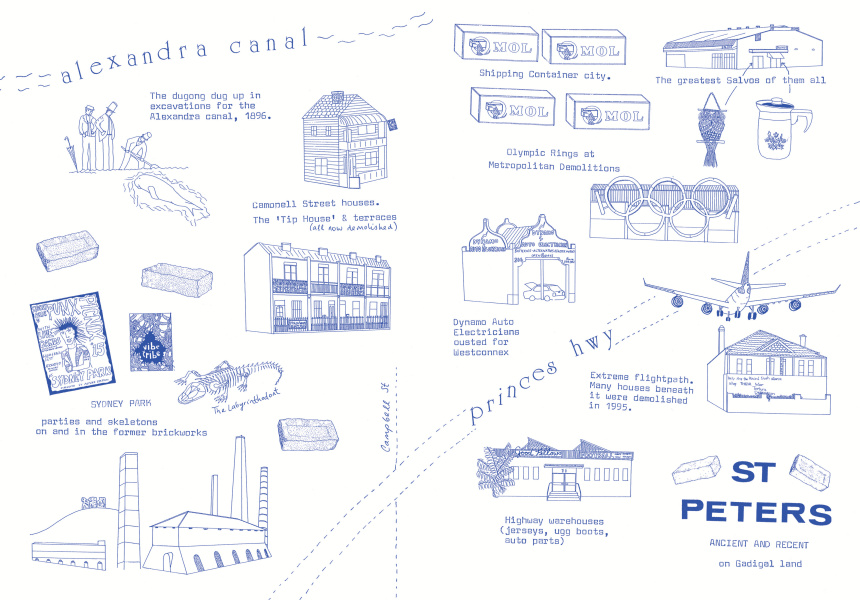I meet Vanessa Berry in a place she describes as “very Mirror Sydney”. It’s the CTA bar, which is below ground in Martin Place, under the MLC building. Inside everything is crimson; the carpets, the plush velveteen booths, the chairs, the bar. It’s like being inside a spongy lung. Midnight Oil and Paul Kelly are on the sound system and pokies blink manically in the corner. This bar was where the Sydney launch for Berry’s book – called Mirror Sydney and based on the blog of the same name, which she has been writing for five years – was held. “It hasn’t changed since the 1970s, which was when this building was built,” she says. “It has its own distinct atmosphere built over decades of staying pretty much the same.”
Mirror Sydney is about the overlooked and odd parts of the city. Through astutely observed essays, maps and illustrations drawn by Berry, this subversive atlas tells the stories of lesser-known places in the city Berry has lived in her whole life and always found fascinating.
But Mirror Sydney is more than a history or a guidebook of the unusual. It’s about paying attention to details of the urban landscape that might at first glance seem banal, or even decrepit. For example, the eventual resting place of the original Olympic rings that hung in Martin Place next to a big screen broadcasting sporting events in 2000.
Never miss a Sydney moment. Make sure you're subscribed to our newsletter today.
SUBSCRIBE NOW“It’s at the edge of this shipping-container yard – it’s a scrapyard,” Berry says. “I was going past one day and I was like, ‘Is that the Olympic rings?’
“I think the scrapyard is proud of them because they’ve put them up nicely on the side of the warehouse, they haven’t been dumped. It’s funny, especially for me who thinks about the different layers of time in the city and memory, that that’s where [the Olympic rings] ended up. It was such a big thing at the time.”
Berry has a background in zine making; the book is full of visual details. “[The drawings] are not really slick, I like the idea that people might look at them and their eye will travel around them.” They may not be “slick”, but they’re not exactly rough, either. They’re like the book as a whole: idiosyncratic, detailed and affectionate.
Berry even finds the beauty in the artery all of Sydney can agree is a pain in any driver’s arse: Parramatta Road. Or if not beauty, at least the weird detail she has a special place for.
“The Parramatta Road story started off with me thinking about its landmarks. Perhaps they’re not what you think of when people use the word ‘landmark’, but they become part of the journey.” Berry’s map of the 23-kilometre east-to-west road features the two mannequins playing the piano (“Mannequin Duet”) on the roof of The Piano Group in Croydon; the six-foot-something teddy bears in the window of a florist in Burwood; The Midnight Star “Once theatre restaurant, once anarchist social centre, now grand ruin” in Homebush; and the sphinx “Keeper of Secrets” outside Euro Iron Pty Ltd in Lidcombe.
A lot of the places Berry has written about for her blog no longer exist or have changed form to make way for mass construction of medium- and high-density buildings. “I’m not really against change,” Berry says. “But I think remembering is really important, and documenting things as they are and have been, especially when it’s places that have stayed the same for a long time.”
Berry writes too about the irony of Sydney’s obsession with owning property (“You can almost taste it at times here.”) on what she acknowledges in the book as stolen land.
“When writing about Sydney – or any place in Australia – it’s important to know and hold within you that it’s Aboriginal land. I try to think of ways that manifests and the ways ideas of ownership obscure that fact, or places where it becomes more present.” In a chapter called “Suburban Time” Berry writes about the mural across from Redfern train station that reads: “40,000 years is a long, long time, 40,000 years still on my mind” – a line from a song by Joe Geia from the band No Fixed Address. “He wrote that song in the 1980s,” says Berry. “That mural was painted in the ’80s and I found that it’s one of the points in the urban landscape that makes you think about the past, and so then you’re also thinking about the present. Because it’s Redfern – one of the areas of Sydney that’s a home of Aboriginal culture.”
It’s 4.30pm and the CTA Bar is closing (“It keeps strange hours,” Berry says). When we emerge into Martin Place, Berry tells me she’s going to a meeting of the group trying to save the Sirius building. She’s surprised and saddened it was just denied heritage status. Sirius is mentioned in her book with this nugget: “To create the model for [Sirius’s] design [architect Tao Gofers] used Revlon eye-shadow cases … ” Sirius might be one of Sydney’s most recogniseable buildings, but it can still be given the Mirror Sydney treatment.
Mirror Sydney is published by Giramondo and is available at bookstores and here.



